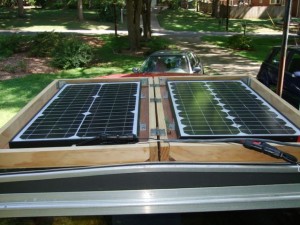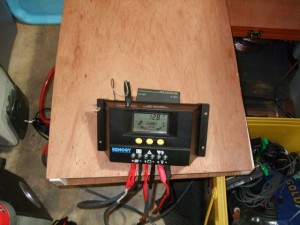Life’s swirl of events led me to be non-committal about FD with the usual suspects this year.  Probably a good thing, given the way brown stuff keeps making sudden contact with the rotary impeller.  Even the minimal home operation in lieu of a real event was in question as days grew shorter.
So 2015 FD was flying solo in the KazShack.   [Some photos here]  The twist to make it FD was to run the station on emergency power, class 1E.  With enough ’round-too-its’ having been previously cashed in to assemble a portion of the battery set up  desired, the battery op seemed feasible. Accumulated over the past year are a couple of 30w solar panels, a pair of well-matched deep cycle marine batteries, a decent charge controller, and assorted minor peripherals(cables, connections, etc).  The original plan was to be ready for NC-QSOP earlier in the year.  Brown Stuff vs Rotary Impeller.  Brown Stuff won, no Qso party.
In field day spirit, I also hoisted an “emergency” field portable 40m/20m inv-V off of a fiberglass telescoping mast obtained from “The Mast Company” several years back.  After collecting dust for these years, it occurred to me that it could fill a big unused space on the edge of the ‘wire-farm’, backed up very nicely by the 20m/40m reflectors in their permanent positions.  This worked very well on both bands during FD, showing four or five S-units difference depending on conditions and the direction of the signals.
The 2015 FD Station:
For the event, I relocated the solar panels to be within reach of the feeder cables to the shack. The batteries had been connected to the solar panels for over a month, so they were nicely topped off.  The batteries were brought into the shack, and connections were set up to power the K2 as the load off the controller.  Not willing to go whole-hog QRP, all transmitting was done at intermediate-low power levels, 45w overnight, 75w during daylight.  (Based on actual current draws by the K2 as measured in place). Add a laptop and ready to go.  The antennas were the normal wire farm plus the hasty-install dipole on the fiberglass mast.
The Solar Problem:
Expected to have poor results from the solar panels, as their default location for the shack is only in full sun in the afternoon. Â Hoped for a sunny afternoon on Saturday. Â No. Such. Luck. Â In fact, the WX really sucked. Â When the WX didn’t suck, there was lightning and rain. Â Zero sunlight. Â The panels only produced about .3amps in shade under clouds, instead of their full-sun 2.8amps. Â 90% reduction.
The good news is the batteries seemed up to the challenge on their own.  Battery voltage dropped to 12.3v at its lowest.  The K2 drew only about 11 amps in transmit, and just over 1/3 amp when in receive. If the panels had been in a good full-sun location the charging would probably have kept up with the demands during daylight operating.  Success.  The charger says that 24ah were drawn over 12 hours of operating, with transmitter power at 50w for the 6 hours on Saturday, and 75w for the 6 hours on Sunday.  In full sun the solar cells would probably have kept the batteries topped off until sundown.
The current draw at full transmit power on the K2 is in the 15A ballpark. Â Rolling the transmit power back to 65 or 75 watts is a good compromise between output power and current demands, as the current draw is closer to 11amps at 70W.
Actual Operating Condx:
WX conditions cut outs a large chunk of Saturday prime time in the late afternoon/early evening. Â So after putzing around for the 1800Z-2000Z hours, did not return to the chair until 0150Z. Â Then a decent three hour stretch, alternating between 40m and a few sweeps of the other bands. Â A nice long nap and the back in the chair well after sunup Sunday morning. Â Not terrible Sunday morning, but not fantastic.
Finished with 532 CW contacts logged and 2128 QSO points. Â Not terrible for only about 10 hours of butt-in-chair time.
So the emergency power and emergency antenna set up worked well enough. Â A bulk of the QSOs were made on the portable antenna. In the shack the charge controller indicated the station drew a total of 24 amp hours. Â The solar cell charging put 9 amp hours back in, not bad given the clouds and shade trees. Â Â That was with the solar cells providing only about half an amp. Â In full daylight the charging would have been sufficient, and closer to 3 amps. Â The power draw had been conservatively estimated/ball-parked/WildAssedGuessed at a need of about 40 amp hours.
The Renogy charge controller is well worth the minor additional expense.  It senses the voltages from both battery and solar panel, and can charge 12v batteries from 24v solar cells if needed.  It also monitors both load and input currents, as well as the battery charge state.  (Seems to be sold under several different name plates, all seem identical based on advertising specs.)
Overall, very happy with the experiment.


Leave a Reply